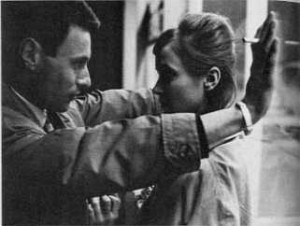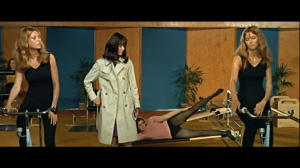From the Sunday, March 24, 1968 New York Times (“Movie Mailbag”). Coincidentally, I had just taken a bus in Manhattan with a friend the previous night to see Godard’s La Chinoise at an avant-premiere screening in Philadelphia, and before boarding the bus back, I bought the Sunday Times and found my letter published there prominently. — J.R.
Godard: Anarchy or Order?
TO THE EDITOR:
I SUPPOSE one should be grateful for The Times’s belated “recognition” of Jean-Luc Godard, particularly after a record of disapproval that has helped to keep much of his work unseen and misunderstood in this country for nearly a decade. But Eugene Archer’s slick comments are painfully inadequate for anyone who knows and cares about Godard’s films. and misleading for anyone who doesn’t. Adhering to a hallowed Times tradition, Archer is informative and interesting whenever he sticks to objective facts about Godard’s career; it is only when he turns to the films themselves that he shows his naivité.
Essential to his understanding of Godard are three questionable assumptions:
l) In order to be an artist, a filmmaker has to be a “dramatist,” not an “essayist.”
2) Godard’s films are composed of arbitrary and unstructured selections of material (“Godard…shoots anything that strikes his fancy and edits it into his film”).
3) Lack of acceptance is the equivalent of artistic failure (“Godard’s second film was a disaster . . . [it] managed the unusual feat of offending all the political factions in France and was banned for years”).
Some of the critical judgments that Archer derives from these unexamined assumptions are curious indeed. Presumably in praise of “Breathless,” he asserts:”Something in the chaos of its structure, the haphazard nature of its dialogue and technique, reflected the tempo of the times.” Faced with the undeniable difficulty and challenge of “Made in U.S.A.” and “Two or Three Things I Know of Her,” he concludes that “neither [makes] much sense, and adds, ungrammatically, that all they prove is that Godard :”obviously can and will make a film anytime, anyhow.” Furthermore, because Godard fails to aim at the lowest common denominator of his audience and refuses to please them in time-tested ways, he is presumed to be an “audience hater.”
By perpetrating a critical myth about Godard — that his films are chaotic and arbitrarily composed — Archer is guilty of the most elementary form of critical negligence. In his use if “documentary” material alongside of “fiction,” Godard is hardly resorting to esthetic anarchy or irresponsible whim. In fact, he is exploiting a basic contradiction that has always existed implicitly in films. Far from subjecting his viewers to random footage, he is interested in ordering his perceptions in a way to instruct our own. His most recent films are simultaneously investigations into and lessons about how to see, hear and understand our everyday existence. Regardless of how one ultimately judges them, it is irresponsible to call them frivolous; far more frivolous is the critical intelligence which refuses to grapple with them.
JONATHAN ROSENBAUM,
Stony Brook University Stony Brook, New York



